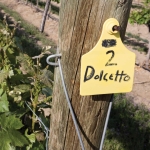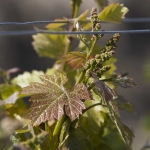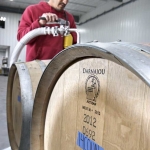Washington State is blessed with a climate that can grow scores of wine grape varieties.
Although it’s a challenge for wineries trying to sell wines of lesser-known varieties, these varieties with unfamiliar names can also help wineries distinguish themselves and strengthen customer loyalty.
Related Stories
The wine market in Washington, with more than 850 bonded wineries, is crowded, and it can be difficult for small wineries to be remembered or recognized. Lesser-known varieties are one way a winery can stand out in the crowd if they are marketed creatively, says Marcus Miller, winemaker and owner of Airfield Estates.
Airfield Estates is a family owned and operated estate winery in Prosser, with tasting rooms in Woodinville and at the Prosser winery.
The family’s first vines were planted in 1968 and today the vineyard includes 27 different wine grape varieties—17 red and 10 white. Five of the red and five of the white varieties are what Miller calls major varieties. The rest are lesser-known cultivars like Counoise, Cinsault, Dolcetto, Barbera, Marsanne, Roussanne, and Muscat Canelli.
About a decade ago when Miller returned to the family business and became winemaker, he used the shotgun approach to expand their varietal acreage. He planted small blocks of lesser-known varieties with the idea that some wouldn’t be successful.
Ten years later, he hasn’t been able to weed out many. “As soon as I get ready to rip one out, it wins a double gold in wine competitions,” he said during a meeting of the Washington Association of Wine Grape Growers.
He made 41 different wines last year, a number he admits is too many. “We’re trying to find focus amidst the chaos,” said Miller, who added that even with more than 40 wines, every wine has its place. They produce some wines for wide distribution, some for their wine club, only, and some are bottled specifically for sampling and sales in their tasting rooms.
Benefits
Miller shared three ways lesser-known varieties can be profitable for a winery:
1. Sales revenue per customer—Lesser-known varieties can help maximize winery sales. Tasting room customers are like hostages. When they are in your tasting room, no one else can sell to them. “If you only offer big, bold Cabernet Sauvignon, the husband may like the wine, but the wife probably wants something softer and sweeter, and you’re missing a sales opportunity.” His highest profit wine is a sweet, late harvest wine.
2. Wine club offerings—Lesser-known varieties add a nice element to wine club shipments and can help keep club offerings fresh. “You don’t want wine club members to get bored and receive the same wine three times in a row,” he said.
3. Scarcity—Most wines sampled in tasting rooms are major varieties like Cabernet Sauvignon and Chardonnay. Lesser-known varieties are not frequently seen on tasting lists and can add scarcity and uniqueness to the tasting list. “If you have only one Cinsault or Barbera to taste, that may be the only opportunity for someone to buy it. Because it’s not sold anywhere else, you create scarcity.
You can take advantage of the fact that they haven’t tried 20 of them that weekend and their knowledge of the varietal is limited to your tasting room.”
Initially, Miller used the lesser-known varieties as blends to gain complexity in his wines. Because Airfield strives to be 100 percent estate fruit, he often has limited blocks and styles of fruit to work with. Lesser-known varieties can add diversity to his wines.
Accent wines
But more and more, he uses the lesser-known varieties as stand alone varietals and blends for wines he calls “accent” wines. These accent wines are made for their tasting rooms and as a basis for their wine club.
“Lesser-known varieties are like having a third pitch in a baseball pitcher’s lineup,” said Miller, and added that they allocate one position on their tasting room lists to a lesser-known variety. “We can sell about 1,000 cases that way, so I make around 250 cases of different varietals wines from cultivars like Dolcetto, Barbera, Tempranillo, and such, and rotate the wines on our tasting room list.”
He noted that they match the varietal being tasted with the weekend. For example, they may list Pinot Noir for Spring Barrel tasting weekend because of its softer approach, yet choose a bold varietal for a wine club weekend with more serious wine drinkers.
Some wines may be offered for tasting only at the wine club level and never listed for general tasting. “We’ll use it for a club release party and include it in a wine club shipment and then have it disappear,” he said.
Miller explained that with his fruit-forward wine style, he sells his lesser-known wines, which are ready to drink, for profitable price points—$25 to $32 per 750ml bottle. For his accent wines, he uses nearly 100 percent varietal with minimal other blends and neutral oak barrels, and he ages the wines for 10 months in oak. By making small amounts, club members can learn about lesser-known varieties.
Big scale
For growers and wineries wanting to take lesser-known varieties to a bigger scale, Miller pointed to the success of Abacela, a southern Oregon winery that specializes in growing and making Tempranillo and Albariño wines.
“I failed miserably at selling our lesser-known varietals in a wider distribution than our tasting rooms,” he said. But Earl Jones, owner of Abacela, has successfully marketed Spanish varietals since 1995 and annually produces about 2,200 cases of Tempranillo and 1,500 cases of Albariño.
Passion is needed to take lesser-known varietals to a scale like Abacela, says Miller. “And, you need to know what the wines taste like on a global scale.” Abacela’s Jones regularly visits Spain and benchmarks his wines against the best Spanish wines, according to Miller.
“If a winery wants you to plant 50 acres of something like Tempranillo or Cabernet Franc—if they are that ambitious to take it to a national scale—then they’d better have the passion of Earl Jones,” he said, and warned against such a large-scale planting for an unproven winery. “If you lose that winery and market, there are few other customers for that kind of quantity of lesser-known varieties.”
Miller believes that lesser-known varieties have a place as accent wines in small production lots of 50 to 500 cases and for blending purposes.
“We can’t sell more than 1,000 cases of lesser-known varieties with the exposure that we give them,” he said. “But varieties like Mourvèdre, Grenache, Malbec, and Petit Verdot can be great blenders.” •










Leave A Comment